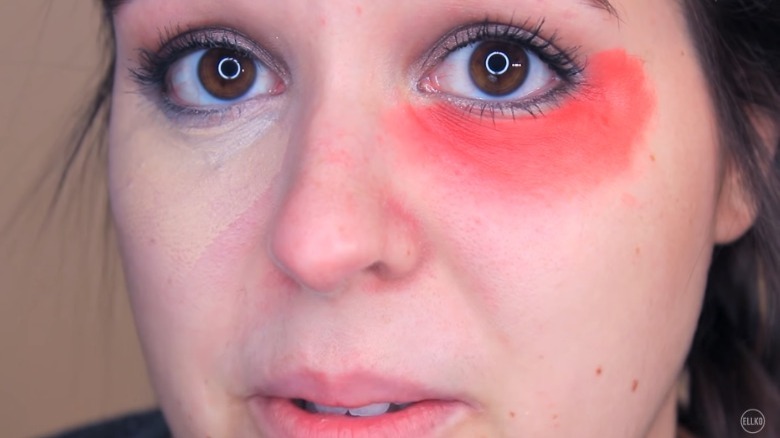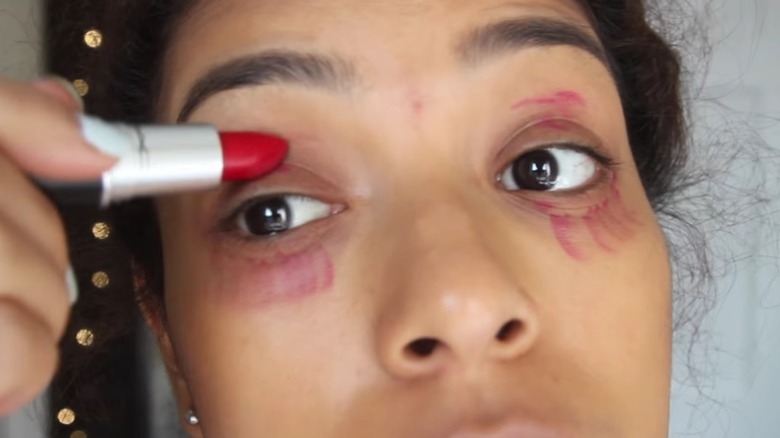Why You Should Never Use Lipstick As Under Eye Concealer
We may receive a commission on purchases made from links.
Using red lipstick as concealer was, like many things we now do on a daily basis, a big trend on the likes of Instagram, TikTok, and YouTube for a while. The viral trend saw a slew of content creators grabbing their favorite red lipstick and putting it over their dark under eye circles, which all seemed a bit odd — until you learn the science behind it. And trust us, there is a method to this madness.
As explained by The Style Blog in a 2020 YouTube video, the idea behind the concept is all about color correcting. The red in the lipstick is almost opposite on the color wheel to blues and purples (the colors we often struggle with around our eyes) meaning it will cancel out the color we usually try to hide under skin-colored concealers. It works in the same way you might put a green concealer on a red blemish or blue to tone down a too orange tan. Make sense right? After applying the initial red color, you're then supposed to cover up the red (hey, no one wants to look like Coco the Clown!) by putting your regular concealer over the top.
But despite there being literally hundreds upon hundreds of videos out there showing our favorite beauty gurus trying out the trend, is it actually safe to be putting lipstick that close to your eye? Well, not exactly.
Lipstick is too greasy for the undereye area
It goes without saying to any makeup junkie that the formulas of concealers and lipsticks are different. Of course. One is made for the sometimes dry, sometimes oily, sometimes smooth, sometimes creased under eye area, while lipstick is designed to stay put on the lips and (usually) moisturize them at the same time. That means, while there are products that can pull double duty, lipstick just isn't designed to be used on the sensitive eye area.
"It's too waxy and greasy. For the average woman, it will be a disaster to blend and layer and if you use it under the eyes, it will crease and smudge," makeup artist Nick Barose explained to Harper's Bazaar of why it's rarely a good idea to be putting your lipstick so close to your eyes, adding that the only reason it can look good in tutorials is because the makeup doesn't need to last. Molly Stern shared a similar take to the outlet, revealing that the products used in the lipstick could even cause breakouts if used on the skin.
Another reason lipstick isn't the best for correcting those pesky dark circles? Siobhán McDonnell (aka LetzMakeup) explained in a YouTube video that red lipsticks won't actually color correct for a lot of people. Red is directly opposite green on the color wheel, meaning it's not going to be 100% effective in toning down blues and purples (you'll need an orange for that).
What to do if you really have to use lipstick under your eyes
Okay, we get it, sometimes you're in a pinch or you've left vital makeup products and home and need extra dark circle coverage. We've all been there! But is there a way to safely use lipstick as concealer if you have no other option? Though we wouldn't recommend ever putting something so close to your eyes that isn't specifically designed to be there, there are ways to make this work if you have no other option (and there are plenty of helpful videos out there too, like this from Ellko or this from Katherin Bolanos).
Makeup artist Rommy Najor recommended to Harper's Bazaar using an orangey red if you want to get rid of darker shadows, while something more peachy-toned would work if you have a light or medium skin tone and less dark shadow. SC suggested always letting the lipstick set before laying concealer on top of it, otherwise you could end up with one sticky and cakey mess. It's also a good idea to make sure you're patting the product into your skin rather than rubbing it in and sliding it around.
Another thing we'd recommend before trying the color correcting trend? Getting your hands on a proper color correcting palette, like the Correct & Perfect All-In-One Color Correcting Palette from Stila ($45 at Sephora). It has all the shades you could need, and, unlike lipstick, it's designed for use on the skin.


